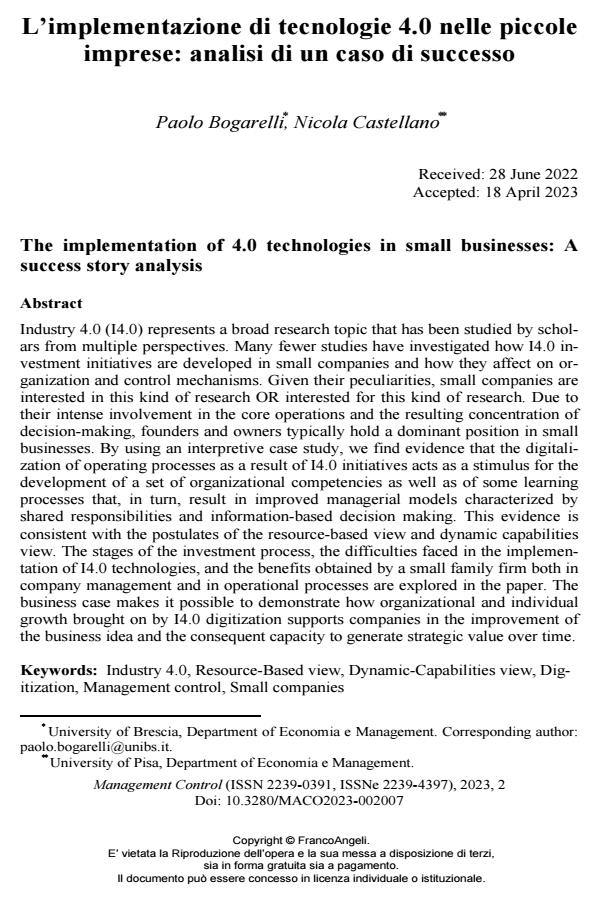The implementation of 4.0 technologies in small businesses: A success story analysis
Journal title MANAGEMENT CONTROL
Author/s Paolo Bogarelli, Nicola Castellano
Publishing Year 2023 Issue 2023/2
Language Italian Pages 28 P. 137-164 File size 775 KB
DOI 10.3280/MACO2023-002007
DOI is like a bar code for intellectual property: to have more infomation
click here
Below, you can see the article first page
If you want to buy this article in PDF format, you can do it, following the instructions to buy download credits

FrancoAngeli is member of Publishers International Linking Association, Inc (PILA), a not-for-profit association which run the CrossRef service enabling links to and from online scholarly content.
Industry 4.0 (I4.0) represents a broad research topic that has been studied by scholars from multiple perspectives. Many fewer studies have investigated how I4.0 investment initiatives are developed in small companies and how they affect on organization and control mechanisms. Given their peculiarities, small compa-nies are interested in this kind of research OR interested for this kind of research. Due to their intense involvement in the core operations and the resulting concen-tration of decision-making, founders and owners typically hold a dominant posi-tion in small businesses. By using an interpretive case study, we find evidence that the digitalization of operating processes as a result of I4.0 initiatives acts as a stimulus for the development of a set of organizational competencies as well as of some learning processes that, in turn, result in improved managerial models char-acterized by shared responsibilities and information-based decision making. This evidence is consistent with the postulates of the resource-based view and dynamic capabilities view. The stages of the investment process, the difficulties faced in the implementation of I4.0 technologies, and the benefits obtained by a small family firm both in company management and in operational processes are explored in the paper. The business case makes it possible to demonstrate how organizational and individual growth brought on by I4.0 digitization supports companies in the improvement of the business idea and the consequent capacity to generate strate-gic value over time.
Keywords: Industry 4.0, Resource-Based view, Dynamic-Capabilities view, Digit-ization, Management control, Small companies
- Exploring the role of digital platforms in promoting value co-creation: evidence from the Italian municipal solid waste management system Luigi Mersico, Selena Aureli, Eleonora Foschi, in Sustainability Accounting, Management and Policy Journal /2025
DOI: 10.1108/SAMPJ-03-2024-0317
Paolo Bogarelli, Nicola Castellano, L’implementazione di tecnologie 4.0 nelle piccole imprese: analisi di un caso di successo in "MANAGEMENT CONTROL" 2/2023, pp 137-164, DOI: 10.3280/MACO2023-002007